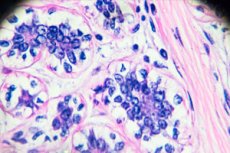New publications
Finnish scientists have found a mechanism to awaken dormant breast cancer cells
Last reviewed: 02.07.2025

All iLive content is medically reviewed or fact checked to ensure as much factual accuracy as possible.
We have strict sourcing guidelines and only link to reputable media sites, academic research institutions and, whenever possible, medically peer reviewed studies. Note that the numbers in parentheses ([1], [2], etc.) are clickable links to these studies.
If you feel that any of our content is inaccurate, out-of-date, or otherwise questionable, please select it and press Ctrl + Enter.

Treatment outcomes for breast cancer have improved in recent years, but some cancers still recur even after long disease-free periods, remaining dormant in the body. Finnish researchers have discovered a mechanism that awakens these dormant breast cancer cells and have shown that preventing this mechanism can significantly improve treatment outcomes in experimental models.
Despite significant improvements in breast cancer treatment outcomes thanks to new evidence-based therapies, it is still the second most common fatal disease in women. A particular challenge in breast cancer treatment is recurrence. Even when treatment appears successful and the cancer is considered cured, it can return years later, either locally or, in the worst case, by spreading to other parts of the body, such as the brain.
The reasons why dormant breast cancer cells awaken after several years are not fully understood. However, identifying them could provide an opportunity to develop new therapies to prevent the cancer from recurring.
DUSP6 Protein Activity Linked to Breast Cancer Cell Awakening
A new Finnish study provides important new data on how breast cancer cells belonging to the HER2-positive subtype can reactivate during treatment.
A research team led by Professor of Cancer Biology Jukka Westermark from the Turku Bioscience Centre and the InFLAMES research flagship of the University of Turku and Åbo Academy approached this question by treating treatment-sensitive breast cancer cells with a HER2 inhibitor for nine months and observing how these cancer cells were able to resume their growth during treatment.
By sequencing molecular changes in the cells, the team identified a protein called DUSP6 whose expression closely followed the development of resistance to therapy. Lead researcher Majid Momeni was also able to show that when DUSP6 activity was blocked during cancer treatment, breast cancer cells lost their ability to grow. Blocking the protein also made previously treatment-resistant cancer cells more sensitive to HER2 inhibitors. Another important finding was that inhibiting DUSP6 slowed the growth of breast cancer metastases to the brain in mice.
Importance of the study
“Based on our findings, blocking the DUSP6 protein may provide the basis for an effective combination therapy also in cases of HER2-positive breast cancer that have already lost their response to treatment,” says Jukka Westermak, Professor of Cancer Biology, Turku Bioscience Centre.
The significance of the study is underscored by the team’s access to experimental drug molecules that inhibit the DUSP6 protein. By administering the drug, the researchers demonstrated that the protein could be inhibited in mice without significant side effects. Importantly, the drug showed significant enhancement of the therapeutic effect of several existing HER2 inhibitors.
“The molecules we used in this study are not yet suitable for treating patients, but these newly published basic research results provide important evidence that DUSP6 is a very promising target protein for future cancer drug development and deserves further study,” Westermack continues.
The research article, “DUSP6 inhibition overcomes Neuregulin/HER3-induced therapy resistance in HER2+ breast cancer,” was published in the prestigious translational medicine journal EMBO Molecular Medicine.
